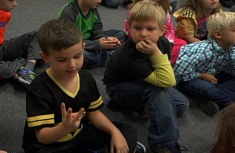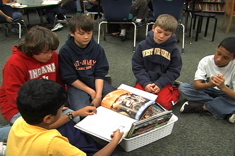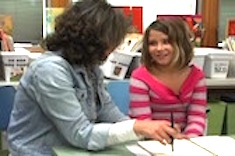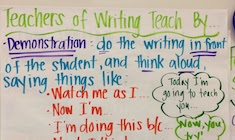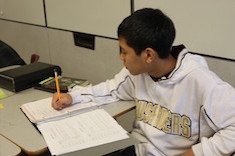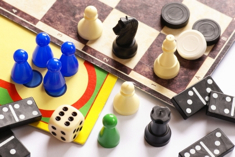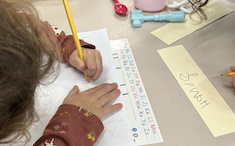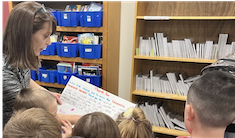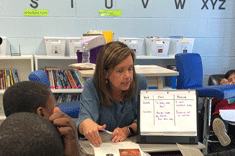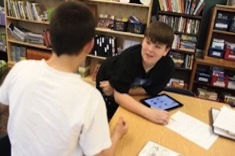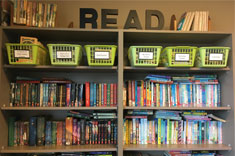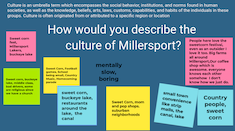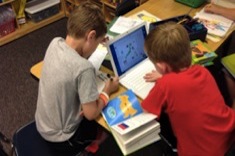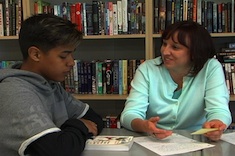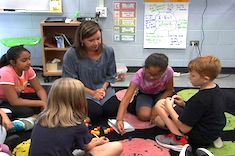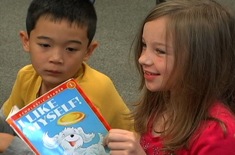Articles
Here is where you’ll find all the latest print features from our contributors. If you’d like to browse specifically by grade level, topic, or contributor, you can use the links in the right sidebar.
Latest Content
Poetry Surprises
Mandy Robek delights in the surprises that emerge as her students read, write, and share poetry.
Student-Generated Questions to Promote Problem Solving and Modeling with Mathematics
Mallory Messenger shares a process for students to engage and solve a type of intriguing question called Fermi Questions.
Turn and Talk, Then What?
Vivian Chen offers useful tips for seasoned and new teachers when it comes to helping students engage in a turn-and-talk.
Learning to Listen During Turn-and-Talk
Ruth Ayres suggests three ways to help students intentionally listen during conversations such as a turn-and-talk.
Authentic Audience
Julie Cox offers three questions to determine authentic audiences for high school students to share work.
Three Ways Student Writers Taught Me How to Use Writing Partnerships
Patty McGee pays attention to how students work as writers to find the teaching points for how to learn to work as writing partners.
Teaching Students to Be Teachers
Tara Barnett and Kate Mills share a process for empowering students to be teachers in partnerships and small-group instruction.
Teaching Writers to Hear Feedback
Cathy Mere outlines ways writers can position themselves to hear (and use) feedback.
It’s the Final Countdown: Using Chunking and Timers to Scaffold Reluctant Writers
What do you do when students won’t write during class? Gretchen Schroeder offers a creative, practical, and effective solution.
Choral Counting Routine
Mallory Messenger shares ways choral counting provides an opportunity for students to share ideas orally, process language and numbers, and bring out vocabulary within the context of looking for patterns.
Level Two Unlocked: Using the Language of Video Games to Engage Students in the Assessment Experience
Heather Fisher considers the research behind gamified experiences and applies it to a lengthy first-grade phonics assessment. Heather challenges us to gamify assessments to maintain the integrity of the assessment while increasing student engagement.
Helping Writers Self-Correct
What to do with writers who catch errors in isolation but not in their own writing? Cathy Mere suggests three ways to help students self-correct their writing.
Do the Hard Thing
Becca Burk reminds all of us that one of the important parts of being a teacher is helping students believe they are capable. Becca shares three practical ways to uplift student capability.
Moving Beyond Asking Questions
Dana Murphy comes to a lesson about asking questions in a curriculum resource and realizes it is not what her students need. She has designed a lesson to make asking questions more meaningful and useful for her students.
Literacy Tool Kits
Inspired by tool kits with math manipulatives, Jen Court created literacy tool kits with the help of her first-grade students. These tool kits grow and change across the year and according to student needs, and they help students “touch their thinking” and become more independent readers and writers.
Building Independence in Problem Solving
Mallory Messenger shares the intentional moves needed to help students build independence in problem solving.
Rural Communities
Julie Cox explores the differences in her experiences of teaching in the city of Louisville and teaching in a rural community. All teens have similar universal experiences, yet Julie outlines some considerations for rural students.
Exploring Rural Literature—A Middle-Grade Booklist
Leigh Anne Eck was named the Indiana Rural Teacher of the Year and shares the way she rethought her library through the lens of reflecting her students’ rural identity or revealing rural stereotypes. This middle-grade booklist is an excellent place for us all to begin expanding our classroom libraries.
Rural Matters: Revealing Perceptions and Celebrating Roots
Gretchen Schroeder addresses the negative and positive perceptions of rural people with her high school students through readings, discussions, and analytical writing. Download a guide for Critical Rural Perspective Analysis to use with your students.
Good Work, Writer
Becca Burk asserts that every child can become a writer when given materials, opportunity, and authentic glimpses into what it means to be a writer. Most importantly, though, children need adults who believe they are writers.
Assessment in Classroom Book Clubs
In this third installment about classroom book clubs, Leigh Anne Eck shares options for robust assessment as well as answers to some frequently asked questions.
Letting Informational Mentors Lead the Way
Tara Barnett and Kate Mills share a practical process for using an informational mentor text to support students as readers and writers. Download a note sheet to support students in noticing text structure.
One-Page Reading Response: A Simple Approach to Complex Assessment
Christy Rush-Levine uses one-page reading responses as a simple culminating activity to provide closure for book clubs. However, the data they offer about readers is far from simple.
Identifying Story Elements
Dana Murphy shares a whole-class conversation about identifying the climax of the plot. She reminds us that defining story elements is not always clear-cut.
Implementing Classroom Book Clubs (Part Two)
In this second installment about book clubs, Leigh Anne Eck shares procedures for book club meetings, as well as discusses the importance of standards and instruction. Download a discussion guide.
Getting Started with Classroom Book Clubs (Part 1)
In the first installment of a three-part series, Leigh Anne Eck clearly lays out how to get started with book clubs. Included is an editable planning bookmark to give students more ownership of their reading schedules.
Less Is More: Using Novels in Verse in the Classroom
Gretchen Schroeder explains the reason why she believes requiring high school students to read novels in verse during independent reading time is worthwhile for their reading identity and developing more sophisticated understandings of literary analysis.
Read Aloud Magic
Jen Court reminds us of the power of reading aloud to students and pushes us to remember the importance of planning to use books to engage students and hone teaching points.
Our Brains on Happiness
Molly James shares the compelling research about the happiness advantage by Shawn Achor and two practical practices to make it a reality in her kindergarten classroom.
Understanding the Beautiful World of Being Multilingual Through the Lens of Brilliance and Complexity
Stella Villalba leads educators through a process to discover the brilliance and complexity of multilingual learners. Rather than searching for a list of strategies, Stella encourages us to linger with our questions and discover multilingual learners’ beauty.
Browse Content By
Type
Category
- Assessment Tools
- Big Fresh Archives
- Booklists
- Choice Numeracy
- Classroom Design
- Common Core
- Community Building
- Conferring
- Content Literacy
- Digital Literacy
- English Language Learners
- Equity
- Family Relations
- Free Samples
- Guiding Groups
- Leadership
- Literacy Coaches
- Mentor Texts
- Minilessons
- New Teacher Mentors
- Podcasts
- Poetry
- Quote Collections
- Reading Strategies
- Self Care
- Struggling and Striving Learners
- Talking and Listening
- Teacher Study Groups
- Teaching Reading
- Teaching Writing
- Word Study and Vocabulary
Author
- Melissa Quimby
- Nawal Qarooni
- Gwen Blumberg
- Julie Cox
- The Lead Learners
- Hannah Tills
- Josie Stewart
- Ruth Metcalfe
- Mallory Messenger
- Becca Burk
- Jodie Bailey
- Vivian Chen
- Mary Brower
- Tiffany Abbott Fuller
- Stephanie Affinito
- Ruth Ayres
- Leigh Anne Eck
- Heather Fisher
- Shari Frost
- Julie Johnson
- Suzy Kaback
- Gigi McAllister
- Shirl McPhillips
- Melanie Meehan
- Cathy Mere
- Debbie Miller
- Tara Barnett and Kate Mills
- Tammy Mulligan
- Dana Murphy
- Bitsy Parks
- David Pittman
- Brenda Power
- Heather Rader
- Matt Renwick
- Mandy Robek
- Christy Rush-Levine
- Gretchen Schroeder
- Jen Schwanke
- Brian Sepe
- Katherine Sokolowski
- Stella Villalba
- Jennifer Vincent
Grade Level
Choice Literacy Membership
Articles
Get full access to all Choice Literacy article content
Videos
Get full access to all Choice Literacy video content
Courses
Access Choice Literacy course curriculum and training


